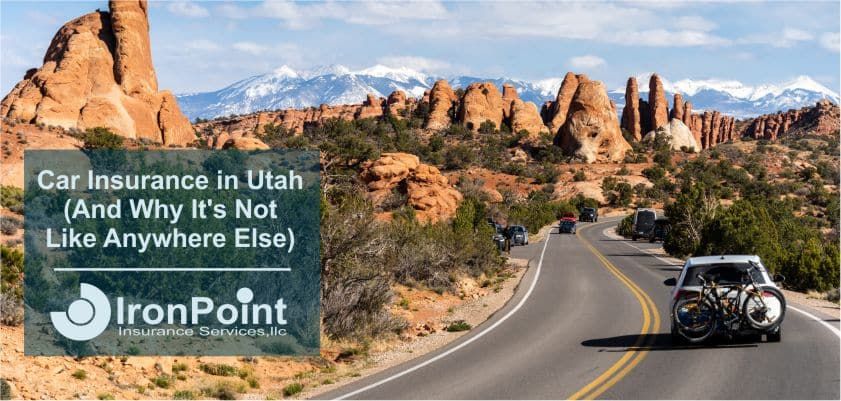Your Guide to Car Insurance in Utah (Why It’s Not Like Anywhere Else)

Driving and car insurance in Utah isn’t like anywhere else.
And no, that’s not some cheesy tourism board slogan. It’s a cold, hard fact backed up by insurance claims data, weather reports, and anyone who’s ever white-knuckled their way down Parley’s Canyon in a snowstorm.
Utah serves up a driving environment that’s equal parts gorgeous and terrifying.
You’ve got:
- Lake-effect snow that can turn I-15 into a skating rink
- Canyon roads where deer have zero respect for your morning commute
- Traffic that’s growing faster than the state’s famous families
This unique driving landscape means Utah car insurance comes with unique rules, risks, and reality checks.
Generic coverage advice from Florida or Nebraska? Useless here.
You need car insurance in Utah designed for its unique weather, and that makes sense for Utah roads.
Here’s what every Utah driver needs to know about staying protected without going broke.
What Makes Driving in Utah Unique
Winter Weather That Doesn’t Play Games
Utah winters separate confident drivers from smart ones.
While other states get gentle snow dustings, Utah gets dumped on by lake-effect storms that transform highways into slip-and-slides without warning.
The Wasatch Mountains aren’t just pretty, they’re snow magnets.
You can leave Salt Lake in 50-degree sunshine and hit a blizzard 20 minutes later. Ask any tow truck driver how many “experienced” drivers they’ve pulled out of ditches because they thought all-season tires were good enough.
This weather reality makes comprehensive coverage non-negotiable for Utah car insurance.
Canyon Roads Where Physics Matters
Utah’s canyon roads are beautiful death traps.
Steep grades, blind curves, and wildlife that didn’t get the memo about staying off asphalt create driving conditions that demand respect.
Add in:
- Tourists who’ve never navigated mountain roads
- Locals who drive them like racetracks
- An elk that appears out of nowhere
Your Car insurance in Utah needs collision coverage when guardrails are the only thing between you and a 500-foot drop.
I-15: The Wasatch Front Parking Lot
Remember when I-15 was just a highway?
Those days are dead and buried under a mountain of California transplants and tech workers.
The Wasatch Front now features Los Angeles-style traffic without Los Angeles infrastructure. More cars plus more congestion equals more fender-benders. It’s math, and it’s expensive math.
Ready to see what proper car insurance in Utah actually costs? Get your personalized quote now—it takes 3 minutes and could save you hundreds.
Utah’s No-Fault Insurance System Explained
Utah operates under a no-fault insurance system, which sounds more complicated than it actually is.
Here’s the simple version:
When you get in an accident, your insurance covers your medical bills first, regardless of who caused the crash. No waiting for the other guy’s insurance company to admit fault. Just faster medical care and less paperwork drama.
This system revolves around Personal Injury Protection (PIP) coverage.
Think of PIP as your insurance company saying, “We’ll handle the medical stuff immediately, sort out blame later.”
But here’s what the DMV brochure won’t tell you: Utah PIP requirements only work well when you have adequate coverage limits. The state minimum might keep you legal, but it won’t keep you financially protected when medical bills pile up.
Smart Utah drivers understand that personal injury protection isn’t just another add-on—it’s financial protection designed specifically for Utah’s fault laws.
Why State Minimums Won’t Save You
Utah requires $25,000 for bodily injury per person, $65,000 per accident, and $15,000 for property damage.
These minimums will keep you legal. They won’t keep you financially safe.
One decent accident involving medical bills or a late-model SUV can blow through these limits faster than a summer thunderstorm.
Most informed Utah drivers buy significantly more Utah liability coverage because they understand that state minimums are starting points, not destinations.
How Utah’s Growth Is Affecting Your Premiums
Utah’s population boom isn’t just changing the skyline—it’s inflating your car insurance in Utah premiums.
What’s Driving Rate Increases
- Tech company growth bringing high-paid workers
- Young families relocating from expensive coastal states
- Retirees discovering Utah’s outdoor lifestyle
More drivers statistically means more accidents, which means higher claims costs for everyone.
Regional Differences Matter
- Rural Utah enjoys lower rates and fewer claims
- The Wasatch Front deals with urban-level risks
- Cache Valley drivers face different challenges than St. George’s explosive growth
Working with Utah insurance professionals who understand these regional variations saves you money while ensuring coverage that fits Utah roads and Utah risks.
How Utah Drivers Can Save Money
Utah’s family-oriented culture creates natural discount opportunities.
- Good Student Discounts: High school and college students can offset their naturally higher rates through academic performance, sometimes saving hundreds per year.
- Safe Driving Programs: Telematics programs work well for responsible drivers who don’t mind proving their habits through smartphone apps. If you’re already careful, get paid for it.
- Winter Preparation Discounts: Some carriers recognize that proper winter tires reduce claims during Utah’s challenging snow season.
- Bundling Policies: Often delivers the biggest savings for Utah homeowners who protect both major assets with one carrier.
Pro tip: Utah’s competitive insurance market rewards annual comparison shopping. Rates vary dramatically between carriers for identical coverage.
Essential Coverage for Utah Drivers
Buying state minimum limits may satisfy the law, but won’t satisfy your bank account when Utah’s unique risks catch up with you.
- Comprehensive Coverage: Essential for Utah driving conditions, including hailstorms that total vehicles in minutes, wildfires that create evacuation scenarios, and theft rates that vary between urban and rural areas.
- Roadside Assistance and Towing: Not luxury add-ons when you might break down in a canyon where cell service is spotty and the nearest tow truck is 40 miles away.
- Rental Reimbursement: Most Utah families depend on their vehicles for everything. When an accident puts your car in the shop for weeks, rental coverage keeps life moving without draining savings.
- Uninsured/Underinsured Motorist Coverage: Protects you when other drivers don’t carry adequate insurance—which happens more than you’d think.
- Higher Liability Limits: Make sense for Utah drivers who own homes or have assets worth protecting.
Need help determining what Utah liability coverage makes sense for your situation? Our comprehensive auto insurance specialists walk you through options that fit your budget.
Practical Tips and Seasonal Preparation for Utah Drivers
Winter essentials:
- Winter tires (insurance discounts possible)
- Emergency kits with blankets and water
- Ice scrapers that work
- Windshield fluid that won’t freeze
Mountain Road Safety
- Maintain extra following distance
- Use lower gears on steep descents
- Watch for wildlife at dawn and dusk
- Scenic views wait until you’re parked
Keep Documentation Handy
Keep insurance cards accessible when traveling to national parks or crossing state lines.
Bottom Line: Get Utah-Smart Car Insurance
Utah driving combines lake-effect snow, canyon roads, explosive population growth, and no-fault insurance laws. These create coverage needs requiring local understanding and Utah-specific solutions.
State minimums keep you legal, but won’t keep you financially protected. Smart Utah drivers invest in coverage matching the state’s actual risks.
Working with a professional insurance agent who understands why PIP coverage matters more in Utah, why comprehensive isn’t optional in hail country, and the difference between Murray and Moab driving makes the difference between protection and expensive mistakes.
See how much you can save on Utah car insurance today. Local risks. Local expertise. Local savings. Get your car insurance in Utah from IronPoint Insurance now. Give us a call, or start the conversation online.
Car Insurance in Utah FAQs
Yes. Utah law requires all drivers to carry at least $3,000 of PIP coverage. This ensures your medical expenses are covered right away after an accident, but most drivers buy higher limits to avoid big out-of-pocket costs.

Get an Auto Insurance Quote
Let us compare auto insurance quotes for you. We make it fast, safe, and secure.
- Let’s Get Started!
-
Have an Agent Call
- Compare Business Quotes
-
Business Owners’ Policy
-
Workers’ Compensation
-
General Liability
-
Commercial Auto
-
Cyber Liability
- Personal Insurance
-
Auto
-
Home / Condo / Renters
-
Motorcycle
-
Classic Car
-
Boat / Yacht
- Quote & Buy Online
-
Small Business Insurance
-
Mexico Auto Insurance
-
Pet Insurance
Call 1-877-334-7646 to speak with an insurance specialist.
Key Takeaways:
- Utah roads are risky: snow, canyons, and congestion demand smarter coverage.
- Skip the minimums: add comprehensive, PIP, and higher liability limits.
- Go local: Utah agents know the risks—and the best ways to save.